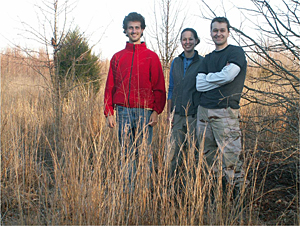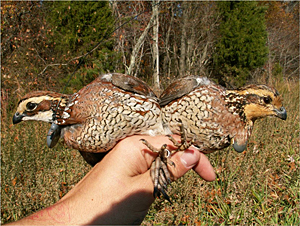
ADVERTISEMENT
- Rozovsky wins prestigious NSF Early Career Award
- UD students meet alumni, experience 'closing bell' at NYSE
- Newark Police seek assistance in identifying suspects in robbery
- Rivlin says bipartisan budget action, stronger budget rules key to reversing debt
- Stink bugs shouldn't pose problem until late summer
- Gao to honor Placido Domingo in Washington performance
- Adopt-A-Highway project keeps Lewes road clean
- WVUD's Radiothon fundraiser runs April 1-10
- W.D. Snodgrass Symposium to honor Pulitzer winner
- New guide helps cancer patients manage symptoms
- UD in the News, March 25, 2011
- For the Record, March 25, 2011
- Public opinion expert discusses world views of U.S. in Global Agenda series
- Congressional delegation, dean laud Center for Community Research and Service program
- Center for Political Communication sets symposium on politics, entertainment
- Students work to raise funds, awareness of domestic violence
- Equestrian team wins regional championship in Western riding
- Markell, Harker stress importance of agriculture to Delaware's economy
- Carol A. Ammon MBA Case Competition winners announced
- Prof presents blood-clotting studies at Gordon Research Conference
- Sexual Assault Awareness Month events, programs announced
- Stay connected with Sea Grant, CEOE e-newsletter
- A message to UD regarding the tragedy in Japan
- More News >>
- March 31-May 14: REP stages Neil Simon's 'The Good Doctor'
- April 2: Newark plans annual 'wine and dine'
- April 5: Expert perspective on U.S. health care
- April 5: Comedian Ace Guillen to visit Scrounge
- April 6, May 4: School of Nursing sponsors research lecture series
- April 6-May 4: Confucius Institute presents Chinese Film Series on Wednesdays
- April 6: IPCC's Pachauri to discuss sustainable development in DENIN Dialogue Series
- April 7: 'WVUDstock' radiothon concert announced
- April 8: English Language Institute presents 'Arts in Translation'
- April 9: Green and Healthy Living Expo planned at The Bob
- April 9: Center for Political Communication to host Onion editor
- April 10: Alumni Easter Egg-stravaganza planned
- April 11: CDS session to focus on visual assistive technologies
- April 12: T.J. Stiles to speak at UDLA annual dinner
- April 15, 16: Annual UD push lawnmower tune-up scheduled
- April 15, 16: Master Players series presents iMusic 4, China Magpie
- April 15, 16: Delaware Symphony, UD chorus to perform Mahler work
- April 18: Former NFL Coach Bill Cowher featured in UD Speaks
- April 21-24: Sesame Street Live brings Elmo and friends to The Bob
- April 30: Save the date for Ag Day 2011 at UD
- April 30: Symposium to consider 'Frontiers at the Chemistry-Biology Interface'
- April 30-May 1: Relay for Life set at Delaware Field House
- May 4: Delaware Membrane Protein Symposium announced
- May 5: Northwestern University's Leon Keer to deliver Kerr lecture
- May 7: Women's volleyball team to host second annual Spring Fling
- Through May 3: SPPA announces speakers for 10th annual lecture series
- Through May 4: Global Agenda sees U.S. through others' eyes; World Bank president to speak
- Through May 4: 'Research on Race, Ethnicity, Culture' topic of series
- Through May 9: Black American Studies announces lecture series
- Through May 11: 'Challenges in Jewish Culture' lecture series announced
- Through May 11: Area Studies research featured in speaker series
- Through June 5: 'Andy Warhol: Behind the Camera' on view in Old College Gallery
- Through July 15: 'Bodyscapes' on view at Mechanical Hall Gallery
- More What's Happening >>
- UD calendar >>
- Middle States evaluation team on campus April 5
- Phipps named HR Liaison of the Quarter
- Senior wins iPad for participating in assessment study
- April 19: Procurement Services schedules information sessions
- UD Bookstore announces spring break hours
- HealthyU Wellness Program encourages employees to 'Step into Spring'
- April 8-29: Faculty roundtable series considers student engagement
- GRE is changing; learn more at April 15 info session
- April 30: UD Evening with Blue Rocks set for employees
- Morris Library to be open 24/7 during final exams
- More Campus FYI >>
2:48 p.m., Sept. 2, 2010----With populations of bobwhite quail declining drastically across the country, Chris Williams, assistant professor of wildlife ecology at the University of Delaware, is turning his attention to saving grasslands and 'edge habitats' -- unkempt, overgrown areas often found on the edges of fields. Both are disappearing due to suburban development and increased efficiency in farming, Williams says.
“The farms themselves have switched so much from this small family farm to this extreme commercialized, 'clean' agriculture, farming every inch of the field you can possibly get,” Williams says. “The habitat is disappearing fast. We have to be very careful about how much land we're losing and converting away from these edge habitats.”
Bobwhite quail, a historically favored game bird, was recently named by the Audubon Society as the number one bird in decline in North America.
Although the Delmarva area has rarely been a target of quail research, the reported quail population per square mile was once one of the highest in the country, yet today is now one of the lowest.
“Because bobwhites were once an admired farmland bird and also a hunted species, we have had a lot of support to understand what's going on with the decline,” he says.
In the past few years, Williams has worked with students in his lab at the College of Agriculture and Natural Resources to study the birds. From 2006 to 2008, graduate students Bridget Collins and Mike Lohr conducted a basic ecology study of bobwhite quail in southern New Jersey. Working with the New Jersey Division of Fish and Wildlife, the students tracked the birds using radio collars to study their habitat, survival rates and daily life during both breeding and non-breeding seasons.
“We had 70 years worth of quail research in the country, and no one had paid attention to the Mid-Atlantic,” Williams says. “We know nothing. We don't know how they're locally using habitat; we don't know what their survival
Ken Duren, another graduate student in the lab, worked with the Delaware Department of Natural Resources and Environmental Control (DNREC) from 2008 to 2009 to map ideal quail habitats in the Delmarva area. Duren visited 180 locations within the state, focusing on agricultural and grassland areas, to determine which locations would serve as suitable quail habitats.
Williams says this research will be used to focus conservation efforts on land that will most benefit the quails. Most farm lands are privately owned, so targeting key bobwhite areas will make more effective use of federal conservation funds.
“We're at a point where the populations are so low that we're going to throw everything we have at core areas and hope to bring back this favored farmland and game bird,” Williams says.



